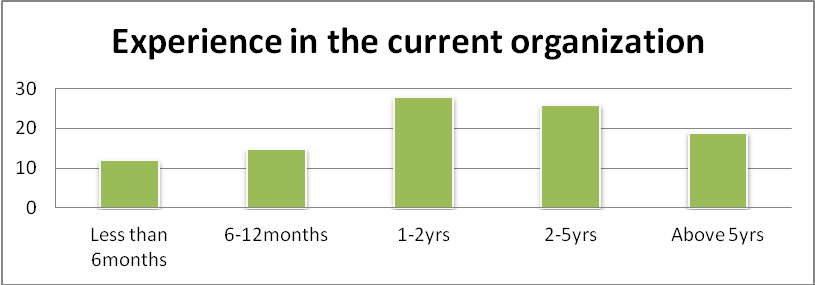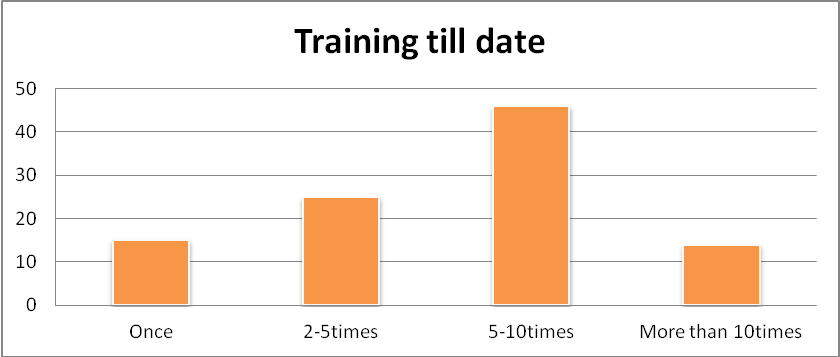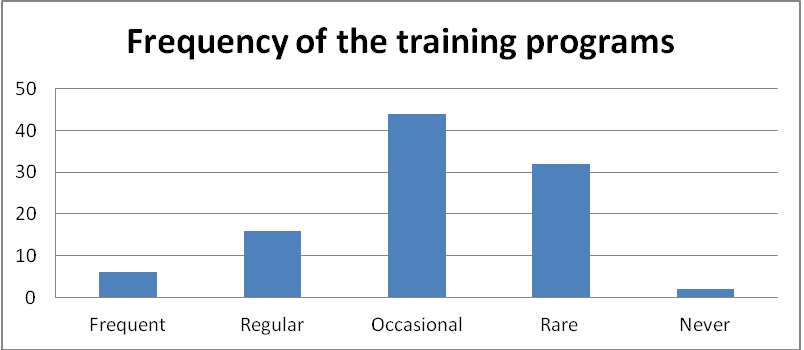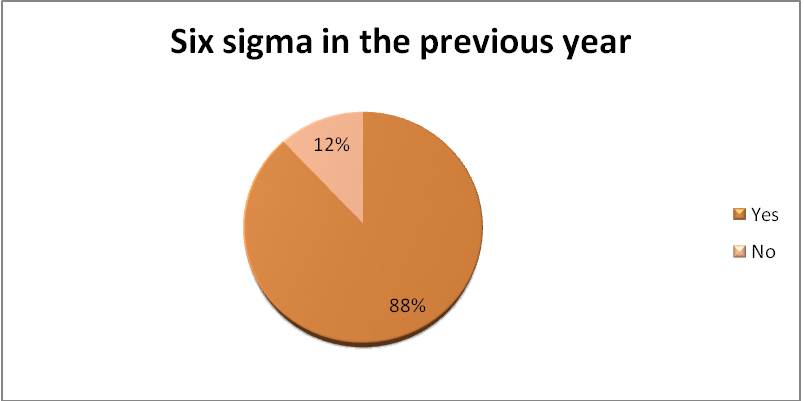OBJECTIVES OF THE STUDY
- To study the impact of six sigma training program on service quality.
- To determine the satisfaction levels of the employees on the training program process using six sigma provided to them.
- To study the gaps in employees effectiveness before and after the six sigma training sessions conducted by the company.
- To find out measures to improve the quality of six sigma training program to be conducted on future employees.
Six sigma processes in the organization involves a lot of planning and efforts in order to be effective. Moreover, it includes huge costs. In order to know whether the six sigma program has met its objectives or not, the management needs to calculate its effectiveness.
SCOPE OF THE STUDY
The study focuses on how the six sigma programs are being conducted in the organization and what is their effectiveness in improving the service quality.
The study being conducted on the six sigma methods followed by an organization, the scope is limited to one organization and its employees. The study collects the responses of the employees in the IT Companies at Hyderabad regarding their perceptions, satisfaction levels and impact on them.
The study focuses on the following factors in order to bring out the effectiveness of Six sigma.
- Frequency of the Six sigma programs
- Duration of the programs
- Selection criteria
- Feed back
- Objectives of the programs
- Support to the trainees
- Confidence level of trainees
- Relevancy of programs to individual needs
- trainer’s theoretical knowledge
- Level of freedom to the trainee
HYPOTHESIS:
Hypothesis 1:
Null hypothesis: There is no effectiveness of the training program using six sigma conducted by the company.
Alternative Hypothesis: There is a effectiveness of the training program using six sigma conducted by the company.
Hypothesis 2:
Null hypothesis: There is no significance impact of six sigma training program on the service quality.
Alternative hypothesis: There is a significance impact of six sigma training program on the service quality
Hypothesis 3:
Null hypothesis: There is no significance satisfaction levels of the employee on the training program using six sigma provided to them.
Alternative hypothesis: There is a significance satisfaction levels of the employee on the training program using six sigma provided to them.
Hypothesis 4:
Null hypothesis: There is no significance whether employees are aware about their responsibilities and authorities in training program on six sigma or not.
Alternative hypothesis: There is a significance whether employees are aware about their responsibilities and authorities in training program on six sigma or not.
Sampling Design:
Sampling involves the procedures that use a small number of units of population to make conclusion regarding the whole population. The sampling design to be followed in this study is as follows.
- Sample frame: The sampling frame IT from among the employees working in IT Companies.
- Sample units: The employees working in IT Companies form part of the sample units.
- Sampling method: The simple random sampling method used to select the respondents
- Sample size: The sample size is limited to 100 employees working at IT Companies.
The following companies IT taken as sample
The 20 The staff working in HR department of five selected IT companies such as TCS, Infosys, Tech Mahindra, IBM and Wipro form part of the Sampling units.
Data collection
The study is based mainly on primary data.
- Primary data sources:
Primary data IT collected through the issue of questionnaire to the employees working at IT Companies.
- Secondary Sources:
Secondary data is the data that collect from the historical/existing sources of data as databases, journals such as Articles, Journals, Magazines and Quality Management Text books, articles, research reports, websites related to six sigma and employees training methods.
Data Analysis: The data analysis IT done using suitable tables, charts, graphs, percentages and other suitable tools.
LIMITATIONS OF THE STUDY
- The study was done on five selected IT companies in Hyderabad
- The study is limited for a period of one month
- The views and opinions of the respondents may change over the period of time
- The approach to six sigma training program may vary from company to company
DIRECTIONS FOR FURTHER RESEARCH:
The study can be further extended by including all the factors which are directly or indirectly affect the Six sigma. The company wants employees to be efficient in their approach in dealing with the customers. This study is a torch bearer for the upcoming management students academicians and companies to know the application of six sigma in training programs undertaken by the company. This research has further scope in dealing with quality control programs on human resources of the company.
CHAPTER IV
DATA ANALYSIS AND INTERPRETATION
How long have you been working in the current organization?
- Less than 6months
- 6-12months
- 1-2yrs
- 2-5yrs
- Above 5yrs
INTERPRETATION: From the above graph, we can notice that 28 respondents has been working in between 1 – 2 years, 26 respondents in between 2 – 5 years, 19 respondents above 5 years, 15 respondents 6 – 12 months and the remaining 12 respondents are less than 6 months.
How times has your organization undergone six sigma as of now?
- Once
- 2 to 5 times
- 5 to 10 times
- More than 10 times
INTERPRETATION: From the above graph, we can notice that 46 respondents has undergone Six sigma in between 5 – 10 times, 25 respondents attended in between 2 – 5 times, 15 respondents attended only one time and 14 respondents attended more than 10 times.
What is the frequency of the Six sigma programs in your organization?
- Frequent
- Regular
- Occasional
- Rare
- Never
INTERPRETATION: From the above graph, 44 respondents as occasionally, 32 respondents as rarely, 16 respondents are regular, 6 respondents as frequently while 2 respondents that they never had a Six sigma programs in their organization.
Have you undergone any Six sigma in the last year?
- Yes
- No
INTERPRETATION: Among 100% respondents, 88% of the employees had undergone Six sigma in the last year 12 respondents are not undergone.
What is the duration of the Six sigma you have undergone?
- A week
- A month
- 1-3 months
- 3-6 months
- More than 6 months
INTERPRETATION: From the above graph, we can notice that 46 respondents has undergone Six sigma for 1 – 3 months, 22 respondents for 3 – 6 months, 14 respondents for a month, 10 respondents for more than 6 months and the remaining 8 respondents for a week.
What types of Six sigma have you undergone till now?
- On the job Six sigma
- Off the job Six sigma
- Both
INTERPRETATION: According to the pie chart, it is observed that 49% has gone for off the job Six sigma and 16% has undergone on the job Six sigma while 25% has taken both the Six sigma.
What is your level of satisfaction with the duration of Six sigma programs?
- Highly satisfied
- Satisfied
- Neither satisfied nor dissatisfied
- Not satisfied
- Not at all satisfied
INTERPRETATION: Majority of the respondents are positive towards the duration of the Six sigma programs. 36 employees are satisfied with the duration of Six sigma programs and 23 employees are highly satisfied. 15 employees are neither satisfied nor dissatisfied and remaining 26 employees are not satisfied with the same.
What is the selection criterion for Six sigma?
- By the department
- By the superior
- By the company
- Don’t know
INTERPRETATION: According to the graph, 42 respondents has chosen the selection criteria for Six sigma by the department, 25 respondents by the superior, 21 respondents by the company and the remaining 12 respondents don’t know about the selection criterion for Six sigma.
Do you get trained periodically in six sigma methods on quality ?
- Yes
- No
INTERPRETATION: From the above chart, it is observed that 68% of the respondents will not train regularly while only 32% IT given Six sigma regularly.
Are you aware about the Six sigma objective which is being selected?
- Yes
- No
INTERPRETATION: According to the pie chart, 73% of the respondents are aware of the Six sigma objective while 27% of the respondents are not aware of the Six sigma objective.
Is your feedback on Six sigma modules considered by the management?
- Yes
- To some extent
- No
- Not aware of
INTERPRETATION: According to the pie graph, only 38% of the feedback on Six sigma module has been considered by the management, 34% to some extent. The remaining 28% feedback has put-off.
Does Six sigma help you in improving skills and tactics for effective execution of job?
- Yes
- To some extent
- No
INTERPRETATION: Six sigma is a systematic development of the knowledge, skills and attitudes required by employees to perform adequately on a given task or job. According to the graph, only 68% of the respondents are benefited through the Six sigma program, 26% of the respondents to some extent. The remaining 6% did not gain any skills through the Six sigma program.
What is the support you receive from your immediate reporting officer in the form of feedback while implementing Six sigma inputs?
- Good
- Moderate
- Poor
- No support at all
INTERPRETATION: According to the graph, 46 respondents received good support from immediate reporting officer, 36 respondents get moderate support. The remaining 18 respondents did not receive any support for the immediate reporting officer.
How much does Six sigma help in your knowledge development?
- Greatly
- To some extent
- A little bit
- Not at all
INTERPRETATION: According to the survey, the Six sigma and development program is productive only for 100 respondents in which 24 respondents feel greatly and 42 respondents to some extent. A little bit of knowledge was gained by 26 respondents and for the remaining 8 respondents it is waste of time and worth.
What is your confidence level to face any higher responsibility after the Six sigma?
- Highly confident
- Confident
- Some confident
- Less confident
- No change in confidence level
INTERPRETATION: According to the graph, the Six sigma helped for 81 respondents to face any higher responsibility person in the organization. 10 respondents are somewhat confident and for remaining 9 respondents the level of confidence is same as before the Six sigma.
Your opinion about the relevancy of course syllabus (or Six sigma topics)
- Much relevant
- Relevant
- A little bit relevant
- Not at all relevant
- Can’t say
INTERPRETATION: According to the graph, 21 respondents are much relevant, 35 respondents are relevant, 29 respondents are a little bit relevant with the Six sigma topics. For remaining 15 respondents the course syllabus/Six sigma topics are irrelevant.
What are the facilities provided during Six sigma?
a.LCD
b.OHP
- Books
- Audio
- Any other
INTERPRETATION: According to the graph, 15 respondents are trained with LCD, 13 respondents with Audio,12 respondents with OHP, 5 respondents with books and the remaining 55 respondents with other facilities.
What is your level of satisfaction on the facilities provided during Six sigma?
- Highly satisfied
- satisfied
- Neither satisfied nor dissatisfied
- Not satisfied
- Not at all satisfied
INTERPRETATION: According to the graph, 39 are highly satisfied and 30 are satisfied with the facilities provided during the Six sigma. Only 13 respondents are dissatisfied with the facilities provided during the Six sigma. The remaining 18 respondents showed a neutral response
How is the trainer’s theoretical knowledge?
- Excellent
- Fair
- Good
- Satisfactory
- Poor
INTERPRETATION: From the above graph, it is noticed that except 3 respondents the remaining respondents are satisfied with the theoretical knowledge of the trainer’s.
Are you satisfied with the relevant examples during Six sigma?
- Highly satisfied
- Satisfied
- Neither satisfied nor dissatisfied
- Not satisfied
- Not at all satisfied
INTERPRETATION: Half of the respondents are satisfied with the relevant examples used during the Six sigma period while 17 are dissatisfied with the relevant examples used during the Six sigma period. The remaining 28 respondents showed a neutral response.
How did you feel about the freedom given to you in expressing and clarifying doubts?
- Fair
- Good
- Satisfactory
- Not satisfactory
- No freedom at all
INTERPRETATION: According to the graph, 38 respondents feel satisfied, 29 respondents feel good and 18 respondents feel as fair with the freedom given in expressing and clarifying the doubts by the trainer. The remaining 15 feel that they have not given enough freedom to express and to clarify.
What is your level of satisfaction of the reading material provided to you during the Six sigma period?
- Highly satisfied
- satisfied
- Neither satisfied nor dissatisfied
- Not satisfied
- Not at all satisfied
INTERPRETATION: Among the respondents, 45 respondents are not satisfied with the reading material provided during the Six sigma period only 25 respondents are satisfied with the reading material. The remaining 30 respondents showed a neutral response.
According to you, what is the level of effectiveness of Six sigma conducted in your organization?
- Highly effective
- Highly ineffective
INTERPRETATION: According to the graph, 16 respondents feel highly effective, 32 respondents feel moderately effective, 24 respondents feel neutral, 17 respondents feel as less effective and 11 respondents are not all effective regarding the Six sigma program conducted in the organization.
FINDINGS, SUGGESTIONS & CONCLUSION:
FINDINGS
- About 53 % of respondents are very much satisfied with duration of the training program 15 employees are neither satisfied nor dissatisfied and remaining 26 employees are dissatisfied with duration consensus.
- According to the survey, 42% respondents has chosen the selection criteria for Six sigma by the department, 25 respondents by the superior, 21 respondents by the company and the remaining 12 respondents don’t know about the selection criterion for Six sigma
- out of 100 respondents, majority of employees do not train regularly while only 32% IT given Six sigma regularly
- Six sigma is a systematic development of the knowledge, skills and attitudes required by employees to perform adequately on a given task or job. According to the graph, only 68% of the respondents are benefited through the Six sigma program, 26% of the respondents to some extent. The remaining 6% did not gain any skills through the Six sigma program
- out of 100 respondents, 82% of respondents extend their good support in reporting to their immediate officer. The remaining 18 respondents did not receive any support for the immediate reporting officer.
- about 64% of respondents feel that development program is productive . A little bit of knowledge was gained by 26 respondents and for the remaining 8 respondents it is waste of time and worth.
- As per the survey, the Six sigma helped for 81 respondents to face any higher responsibility person in the organization. 10 respondents are somewhat confident and for remaining 9 respondents the level of confidence is same as before the Six sigma.
- majority of respondents are satisfied with the facilities provided during the Six sigma. Only 13 respondents are dissatisfied with the facilities provided during the Six sigma. The remaining 18 respondents showed a neutral responds.
- 48 respondents take effective stand towards poll, 24 respondents feel neutral, 17 respondents feel as less effective and 11 respondents are not all effective regarding the Six sigma program conducted in the organization.
- 15 respondents are trained with LCD, 13 respondents with Audio,12 respondents with OHP, 5 respondents with books and the remaining 55 respondents with other facilities.
SUGGESTIONS
- organization need to use number of measurement and approaches to establish current performance.
- organization need to use appropriately a number of basic analysis tools and techniques to establish the root cause of a problem.
- Understand key lean concepts and tools, when and how to apply them to drive improvements
- Recognize the difference in approach and techniques for incremental and redesign improvement strategies and know how to decide on the correct approach.
- Establish ongoing process controls and process governance structures
- Decisions in my department are made with the input from people who IT affected by the decision
- By this study we can suggest to use Value Stream Mapping to show the linkage between merits and worth in training
- There can be projects like creating self-learning and evaluation modules for the employees
- It is recommended that the whole population of trainers in the department undergo a survey tackling on issues of morale and how they feel things can change for the better
CONCLUSION
A study on employee training using six sigma approach at IT Companies. It comprises of a dynamic and enthusiastic team determined to accomplish the vision of the companies long term and short term goals.
An organization needs to frame its policies in a way that they are accepted by its internal customers and there by achieve higher turn productivity.
Employee training program at different levels in the organization depends upon the experience of the employee considering there feedback at various levels in the organization six sigma helps us in achieving required standards for the organization in short period.
Therefore, employee training program using six sigma is of much essence in an organization and it has considerable impact on the performance and the top management should also take care of various measures and strategies to enhance the employee training program.




